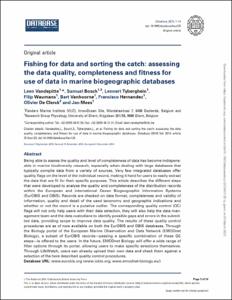| dc.contributor.author | Vandepitte, Leen | |
| dc.contributor.author | Bosch, Samuel | |
| dc.contributor.author | Tyberghein, Lennert | |
| dc.contributor.author | Waumans, Filip | |
| dc.contributor.author | Vanhoorne, Bart | |
| dc.contributor.author | Hernandez, Francisco | |
| dc.contributor.author | De Clerck, Olivier | |
| dc.contributor.author | Mees, Jan | |
| dc.date.accessioned | 2023-07-24T20:29:21Z | |
| dc.date.available | 2023-07-24T20:29:21Z | |
| dc.date.issued | 2015 | |
| dc.identifier.citation | Vandepitte, L. et al (2015) Fishing for data and sorting the catch: assessing the data quality, completeness and fitness for use of data in marine biogeographic databases, Database, Volume 2015:bau125, 14pp. DOI: https://doi.org/10.1093/database/bau125 | en_US |
| dc.identifier.uri | https://repository.oceanbestpractices.org/handle/11329/2334 | |
| dc.description.abstract | Being able to assess the quality and level of completeness of data has become indispensable
in marine biodiversity research, especially when dealing with large databases that
typically compile data from a variety of sources. Very few integrated databases offer
quality flags on the level of the individual record, making it hard for users to easily extract
the data that are fit for their specific purposes. This article describes the different steps
that were developed to analyse the quality and completeness of the distribution records
within the European and international Ocean Biogeographic Information Systems
(EurOBIS and OBIS). Records are checked on data format, completeness and validity of
information, quality and detail of the used taxonomy and geographic indications and
whether or not the record is a putative outlier. The corresponding quality control (QC)
flags will not only help users with their data selection, they will also help the data management
team and the data custodians to identify possible gaps and errors in the submitted
data, providing scope to improve data quality. The results of these quality control
procedures are as of now available on both the EurOBIS and OBIS databases. Through
the Biology portal of the European Marine Observation and Data Network (EMODnet
Biology), a subset of EurOBIS records—passing a specific combination of these QC
steps—is offered to the users. In the future, EMODnet Biology will offer a wide range of
filter options through its portal, allowing users to make specific selections themselves.
Through LifeWatch, users can already upload their own data and check them against a
selection of the here described quality control procedures. | en_US |
| dc.language.iso | en | en_US |
| dc.rights | Attribution 4.0 International | * |
| dc.rights.uri | http://creativecommons.org/licenses/by/4.0/ | * |
| dc.subject.other | Biodiversity data | |
| dc.title | Fishing for data and sorting the catch: assessing the data quality, completeness and fitness for use of data in marine biogeographic databases. | en_US |
| dc.type | Journal Contribution | en_US |
| dc.description.refereed | Refereed | en_US |
| dc.format.pagerange | 14pp. | en_US |
| dc.identifier.doi | https://doi.org/10.1093/database/bau125 | |
| dc.subject.parameterDiscipline | Biota abundance, biomass and diversity | en_US |
| dc.subject.dmProcesses | Data quality control | en_US |
| dc.bibliographicCitation.title | Database | en_US |
| dc.bibliographicCitation.volume | 2015 | en_US |
| dc.description.sdg | 14.a | en_US |
| dc.description.maturitylevel | Pilot or Demonstrated | en_US |
| dc.description.adoption | Organisational | en_US |
| dc.description.methodologyType | Method | en_US |
| dc.description.methodologyType | Specification of criteria | en_US |
| obps.contact.contactname | Leen Vandepitte | |
| obps.contact.contactemail | leen.vandepitte@vliz.be | |
| obps.resourceurl.publisher | https://academic.oup.com/database/article/doi/10.1093/database/bau125/2433125 | |
 Repository of community practices in Ocean Research, Applications and Data/Information Management
Repository of community practices in Ocean Research, Applications and Data/Information Management

